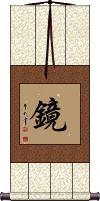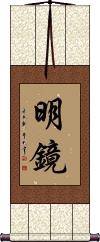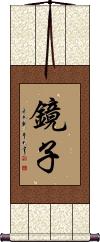Many custom options...
And formats...

Mirror in Chinese / Japanese...
Buy a Mirror calligraphy wall scroll here!
Personalize your custom “Mirror” project by clicking the button next to your favorite “Mirror” title below...
Mirror
鏡 is a Chinese character, Japanese Kanji and Korean Hanja that means mirror.
It can also mean lens or looking-glass depending on context.
In Buddhism, this is the equivalent of ādarśa from Sanskrit meaning a mirror.
Flower in the Mirror, Moon on Water
鏡花水月 is an old Asian proverb that means “flowers in a mirror and the moon reflected in the lake” or “flowers reflected on a mirror and the moon reflected on the water's surface.”
Literally, 鏡花水月 reads “Mirror Flower, Water Moon.”
Figuratively this can be used to represent a lot of different ideas. It can be used to express an unrealistic rosy view or viewing things through rose-tinted spectacles. So you can use it to relay an idea about something that is visible but has no substance,
something that can be seen but not touched, or something beautiful but unattainable such as dreams or a mirage.
This expression is used to describe things like the subtle and profound beauty of poems that cannot be described in words.
鏡 = Mirror (or lens)
花 = Flower(s)
水 = Water
月 = Moon
Can also be written 水月鏡花 (just a slight change in word/character order).
Broken Mirror Rejoined
Used in modern times for divorced couples that come back together
破鏡重圓 is about a husband and wife who were separated and reunited.
About 1500 years ago in China, there lived a beautiful princess named Le Chang. She and her husband Xu De Yan loved each other very much. But when the army of the Sui Dynasty was about to attack their kingdom, disposed of all of their worldly possessions and prepared to flee into exile.
They knew that in the chaos, they might lose track of each other, so the one possession they kept was a bronze mirror which is a symbol of unity for a husband and wife. They broke the mirror into two pieces, and each of them kept half of the mirror. They decided that if separated, they would try to meet at the fair during the 15th day of the first lunar month (which is the lantern festival). Unfortunately, the occupation was brutal, and the princess was forced to become the mistress of the new commissioner of the territory, Yang Su.
At the Lantern Festival the next year, the husband came to the fair to search for his wife. He carried with him his half of the mirror. As he walked through the fair, he saw the other half of the mirror for sale at a junk market by a servant of the commissioner. The husband recognized his wife's half of the mirror immediately, and tears rolled down his face as he was told by the servant about the bitter and loveless life that the princess had endured.
As his tears dripped onto the mirror, the husband scratched a poem into his wife's half of the mirror:
You left me with the severed mirror,
The mirror has returned, but absent are you,
As I gaze in the mirror, I seek your face,
I see the moon, but as for you, I see not a trace.
The servant brought the inscribed half of the mirror back to the princess. For many days, the princess could not stop crying when she found that her husband was alive and still loved her.
Commissioner Yang Su, becoming aware of this saga, realized that he could never obtain the princess's love. He sent for the husband and allowed them to reunite.
This proverb, 破鏡重圓, is now used to describe a couple who has been torn apart for some reason (usually divorce) but have come back together (or remarried).
It seems to be more common these days in America for divorced couples to reconcile and get married to each other again. This will be a great gift if you know someone who is about to remarry their ex.
Mirror: Beautiful Clarity
While 明鏡 means mirror in Chinese, Japanese Kanji, and old Korean Hanja, it's commonly used as a metaphor for something beautiful and bright or something that provides clarity and insight.
Keiko
Mirror
This in-stock artwork might be what you are looking for, and ships right away...
Gallery Price: $60.00
Your Price: $36.88
Gallery Price: $60.00
Your Price: $36.88
Gallery Price: $67.00
Your Price: $36.88
Gallery Price: $60.00
Your Price: $36.88
Not the results for mirror that you were looking for?
Below are some entries from our dictionary that may match your mirror search...
| Characters If shown, 2nd row is Simp. Chinese |
Pronunciation Romanization |
Simple Dictionary Definition |
鏡 镜 see styles |
jìng jing4 ching kagami かがみ |
More info & calligraphy: Mirror(1) mirror; looking-glass; (2) barrel head; (3) {finc} page added at the beginning of a document mentioning its purpose, date, author, etc.; (4) (abbreviation) (See 鏡餅・かがみもち) mirror-shaped mochi; (female given name) Mira ādarśa. A mirror. |
明鏡 明镜 see styles |
míng jìng ming2 jing4 ming ching meikyou / mekyo めいきょう |
More info & calligraphy: Mirror: Beautiful Claritypolished mirror; clear mirror; (personal name) Meikyō a [clear] mirror |
鏡子 镜子 see styles |
jìng zi jing4 zi5 ching tzu keiko / keko けいこ |
More info & calligraphy: Keiko(female given name) Keiko |
ミラー see styles |
miraa / mira ミラー |
More info & calligraphy: Miller |
破鏡重圓 破镜重圆 see styles |
pò jìng chóng yuán po4 jing4 chong2 yuan2 p`o ching ch`ung yüan po ching chung yüan |
More info & calligraphy: Broken Mirror Rejoined |
鏡花水月 镜花水月 see styles |
jìng huā shuǐ yuè jing4 hua1 shui3 yue4 ching hua shui yüeh kyoukasuigetsu / kyokasuigetsu きょうかすいげつ |
More info & calligraphy: Flower in the Mirror, Moon on Water(yoji) flowers reflected on a mirror and the moon reflected on the water's surface; something that is visible but having no substance; the subtle and profound beauty of poems that cannot be described in words |
鐩 𬭼 see styles |
suì sui4 sui |
(literary) brass mirror used to light a fire by focusing the sun's rays |
鑑 鉴 see styles |
jiàn jian4 chien miru みる |
bronze mirror (used in ancient times); to reflect; to mirror; something that serves as a warning or a lesson; to examine; to scrutinize model; pattern; (female given name) Miru A mirror 明鑑; to note, survey, 鑑察. |
㐄 see styles |
kuà kua4 k`ua kua |
component in Chinese characters, mirror image of 夂[zhi3] |
一鏡 一镜 see styles |
yī jìng yi1 jing4 i ching ikkyou / ikkyo いっきょう |
(surname) Ikkyō a single mirror |
主鏡 see styles |
shukyou / shukyo しゅきょう |
primary mirror (of a telescope); main mirror |
亀鑑 see styles |
kikan きかん |
pattern; example; model; paragon; mirror; (given name) Kikan |
二如 see styles |
èr rú er4 ru2 erh ju ninyo |
There are various definitions of the two aspects of the 眞如 bhūtatathatā. (1) (a) 不變眞如 The changeless essence or substance, e.g. the sea; (b) 隨緣眞如 its conditioned or ever-changing forms, as in the phenomenal world, e.g. the waves. (2) (a) 離言眞如 The inexpressible absolute, only mentally conceivable; (6) 依言眞如 aspects of it expressible in words, its ideal reflex. (3) (a) 空眞如 The absolute as the void, e.g. as space, the sky, a clear mirror; (b) 不空眞如 the absolute in manifestation, or phenomenal, e. g. images in the mirror: the womb of the universe in which are all potentialities. (4) (a) 在纏眞如The Buddha-nature in bonds, i.e. all beings in suffering; (b) 出纏真如the Buddha-nature set free by the manifestation of the Buddha and bodhisattvas. (5) (a) 有垢眞如The Buddha-nature defiled, as in unenlightened man, etc., e.g. the water-lily with its roots in the mud; (b) 無垢眞如 the pure Buddha-nature, purifed or bright as the full moon. (6) 安立 and 非安立眞如 similar to the first definition given above. |
五智 see styles |
wǔ zhì wu3 zhi4 wu chih gochi ごち |
(place-name, surname) Gochi The five kinds of wisdom of the 眞言宗 Shingon School. Of the six elements 六大 earth, water, fire, air (or wind), ether (or space) 曇空, and consciousness (or mind 識 ), the first five form the phenomenal world, or Garbhadhātu, the womb of all things 胎藏界, the sixth is the conscious, or perceptive, or wisdom world, the Vajradhātu 金剛界, sometimes called the Diamond realm. The two realms are not originally apart, but one, and there is no consciousness without the other five elements. The sixth element, vijñāna, is further subdivided into five called the 五智 Five Wisdoms: (1) 法界體性智 dharmadhātu-prakṛti-jñāna, derived from the amala-vijñāna, or pure 識; it is the wisdom of the embodied nature of the dharmadhātu, defined as the six elements, and is associated with Vairocana 大日, in the centre, who abides in this samādhi; it also corresponds to the ether 空 element. (2) 大圓鏡智 adarśana-jñāna, the great round mirror wisdom, derived from the ālaya-vijñāna, reflecting all things; corresponds to earth, and is associated with Akṣobhya and the east. (3) 平等性智 samatā-jñāna, derived from mano-vijñāna, wisdom in regard to all things equally and universally; corresponds to fire, and is associated with Ratnasaṃbhava and the south. (4) 妙觀察智 pratyavekṣaṇa-jñāna, derived from 意識, wisdom of profound insight, or discrimination, for exposition and doubt-destruction; corresponds to water, and is associated with Amitābha and the west. (5) 成所作智 kṛtyānuṣṭhāna-jñāna, derived from the five senses, the wisdom of perfecting the double work of self-welfare and the welfare of others; corresponds to air 風 and is associated with Amoghasiddhi and the north. These five Dhyāni-Buddhas are the 五智如來. The five kinds of wisdom are the four belonging to every Buddha, of the exoteric cult, to which the esoteric cult adds the first, pure, all-refecting, universal, all-discerning, and all-perfecting. |
五法 see styles |
wǔ fǎ wu3 fa3 wu fa gohō |
pañcadharma. The five laws or categories, of which four groups are as follows: I. 相名五法 The five categories of form and name: (1) 相 appearances, or phenomena; (2) 名 their names; (3) 分別 sometimes called 妄想 ordinary mental discrimination of them— (1) and (2) are objective, (3) subjective; (4) 正智 corrective wisdom, which corrects the deficiencies and errors of the last: (5) 如如 the 眞如 Bhutatathata or absolute wisdom, reached through the 如理智 understanding of the law of the absolute, or ultimate truth. II. 事理五法 The five categories into which things and their principles are divided: (1) 心法 mind; (2) 心所法 mental conditions or activities; (3) 色法 the actual states or categories as conceived; (4) 不相應法 hypothetic categories, 唯識 has twenty-four, the Abhidharma fourteen; (5) 無爲法 the state of rest, or the inactive principle pervading all things; the first four are the 事 and the last the 理. III. 理智五法 cf. 五智; the five categories of essential wisdom: (1) 眞如 the absolute; (2) 大圓鏡智 wisdom as the great perfect mirror reflecting all things; (3) 平等性智 wisdom of the equal Buddha nature of all beings; (4) 妙觀察智 wisdom of mystic insight into all things and removal of ignorance and doubt; (5) 成所作智 wisdom perfect in action and bringing blessing to self and others. IV. 提婆五法 The five obnoxious rules of Devadatta: not to take milk in any form, nor meat, nor salt; to wear unshaped garments, and to live apart. Another set is: to wear cast-off rags, beg food, have only one set meal a day, dwell in the open, and abstain from all kinds of flesh, milk, etc. |
倒寫 倒写 see styles |
dào xiě dao4 xie3 tao hsieh |
mirror writing; upside down writing |
倭鏡 see styles |
wakyou / wakyo わきょう |
Japanese-style mirror |
光軸 see styles |
koujiku / kojiku こうじく |
(1) {physics} optical axis (of a lens, spherical mirror, etc.); (2) {physics} (See 光学軸) optic axis (of a crystal) |
円鏡 see styles |
enkyou; marukagami / enkyo; marukagami えんきょう; まるかがみ |
round mirror; (given name) Enkyō |
凸鏡 凸镜 see styles |
tū jìng tu1 jing4 t`u ching tu ching tokkyou / tokkyo とっきょう |
convex mirror convex mirror |
凹鏡 凹镜 see styles |
āo jìng ao1 jing4 ao ching |
concave mirror |
副鏡 see styles |
fukukyou / fukukyo ふくきょう |
secondary mirror (in a reflecting telescope) |
反射 see styles |
fǎn shè fan3 she4 fan she hansha はんしゃ |
to reflect; reflection (from a mirror etc); reflex (i.e. automatic reaction of organism) (n,vs,vt,vi) (1) {physics} reflection; reverberation; (2) {physiol} reflex; reflexes |
反映 see styles |
fǎn yìng fan3 ying4 fan ying hanei / hane はんえい |
to mirror; to reflect; mirror image; reflection; (fig.) to report; to make known; to render (noun/participle) (1) reflection (light, image, situation, attitude, etc.); reflecting; (2) influence; application (e.g. of an update) |
古鏡 古镜 see styles |
gǔ jìng gu3 jing4 ku ching kokyou / kokyo こきょう |
(given name) Kokyō ancient mirror |
和鏡 see styles |
wakyou / wakyo わきょう |
Japanese-style mirror |
四智 see styles |
sì zhì si4 zhi4 ssu chih shichi |
The four forms of wisdom of a Buddha according to the 法相 Dharmalakṣana school: (1) 大圓鏡智 the great mirror wisdom of Akṣobhya; (2) 平等性智 the universal wisdom of Ratnaketu; (3) 妙觀察智 the profound observing wisdom of Amitābha; (4) 成所作智 the perfecting wisdom of Amoghasiddhi. There are various other groups. |
四鏡 四镜 see styles |
sì jìng si4 jing4 ssu ching yotsukagami よつかがみ |
(surname) Yotsukagami The four resemblances between a mirror and the bhūtatathatā in the Awakening of Faith 起信論. The bhūtatathatā, like the mirror, is independent of all beings, reveals all objects, is not hindered by objects, and serves all beings. |
圓鏡 圆镜 see styles |
yuán jìng yuan2 jing4 yüan ching en kyō |
round mirror |
大鑑 see styles |
dà jiàn da4 jian4 ta chien taikan たいかん |
encyclopedia great mirror |
Click here for more mirror results from our dictionary
The following table may be helpful for those studying Chinese or Japanese...
| Title | Characters | Romaji (Romanized Japanese) | Various forms of Romanized Chinese | |
| Mirror | 鏡 镜 | kagami | jìng / jing4 / jing | ching |
| Flower in the Mirror, Moon on Water | 鏡花水月 镜花水月 | kyou ka sui getsu kyoukasuigetsu kyo ka sui getsu | jìng huā shuǐ yuè jing4 hua1 shui3 yue4 jing hua shui yue jinghuashuiyue | ching hua shui yüeh chinghuashuiyüeh |
| Broken Mirror Rejoined | 破鏡重圓 破镜重圆 | pò jìng chóng yuán po4 jing4 chong2 yuan2 po jing chong yuan pojingchongyuan | p`o ching ch`ung yüan pochingchungyüan po ching chung yüan |
|
| Mirror: Beautiful Clarity | 明鏡 明镜 | mei kyou / meikyou / mei kyo | míng jìng ming2 jing4 ming jing mingjing | ming ching mingching |
| Keiko | 鏡子 镜子 | keiko | jìng zi / jing4 zi5 / jing zi / jingzi | ching tzu / chingtzu |
| In some entries above you will see that characters have different versions above and below a line. In these cases, the characters above the line are Traditional Chinese, while the ones below are Simplified Chinese. | ||||
Successful Chinese Character and Japanese Kanji calligraphy searches within the last few hours...












